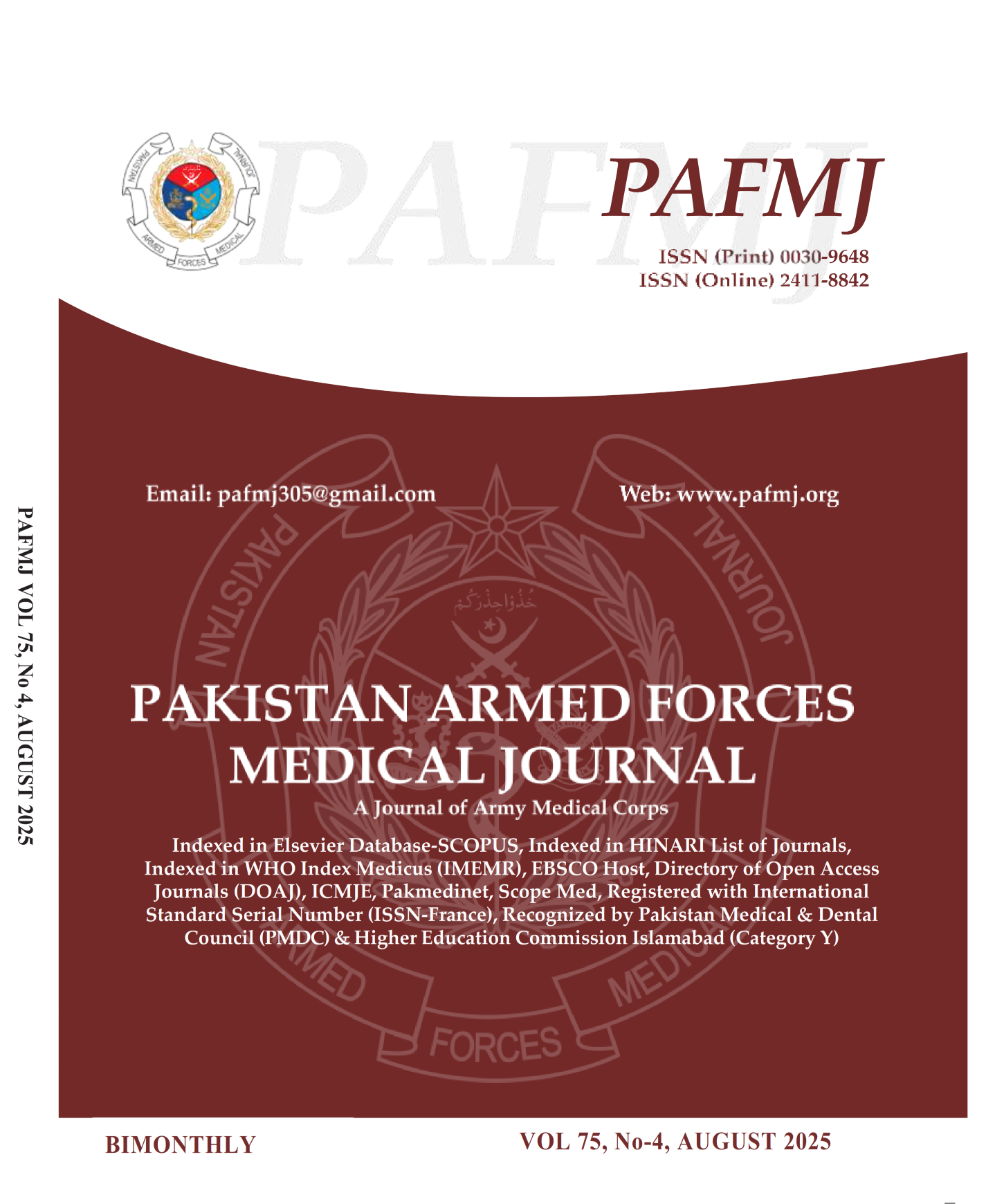Sports Injuries and their Association with Entry Level Body Mass Index in Young Athletes: a Case Control Study
DOI:
https://doi.org/10.51253/pafmj.v75i4.12953Keywords:
Body Mass Index, Musculo-skeletal injuries, Sports InjuriesAbstract
Objective: To find the association between sports injuries and entry level body mass index in young athletes.
Study Design: Case Control Study.
Place and Duration of Study: Different Sports Academies of Abbottabad, Pakistan from Sep 2021 to Aug 2022.
Methodology: Newly inducted young athletes, aged between 19 – 23 years, were included in the study. Record of the athletes was explored to note their entry level BMI, along with the personal and medical history. Those who got sports injuries during first three months of training were labeled as cases. Those athletes who remained injury free but otherwise were similar to cases in all aspects were labeled as controls. Controls were selected at Case: Control ratio of 1:2. BMI was divided into five categories.
Results: A total of 1302 male participants were included in this study. Out of these, 434 participants (0.33%) had received sports injuries (cases), whereas the remaining 868 participants (0.66%) were injury free (controls). A strong association of sports injuries was observed with lower entry level BMI, in the cases (p-value=0.02). Furthermore, 40(87%) of the cases belonged to Category 1 (BMI <18 Kg/m2) while 164 (80.4%) were within Category 2(BMI =18.1-18.4 Kg/m2). The lowest percentage of sports injuries i.e. 8.3% (22 participants) was observed in Cat 4 (BMI = 23.1-24.9 Kg/m2).
Conclusion: The study provides scientific evidence of association of sports injuries with lower entry level BMI. It implies that sports injuries can be prevented by revising selection standards of .....
Downloads
References
1. Emery CA, Pasanen K. Current trends in sport injury prevention. Best Pract Res Clin Rheumatol 2019; 33(1): 3-15.
http://doi.org/10.1016/j.berh.2019.02.009
2. Emery CA, Roy TO, Whittaker JL, Nettel-Aguirre A, van Mechelen W. Neuromuscular training injury prevention strategies in youth sport: a systematic review and meta-analysis. Br J Sports Med 2015; 49(13): 865-70.
http://doi.org/10.1136/bjsports-2015-094639
3. Pol R, Hristovski R, Medina D, Balague N. From microscopic to macroscopic sports injuries. Applying the complex dynamic systems approach to sports medicine: a narrative review. Br J Sports Med 2019; 53(19): 1214-1220.
http://doi.org/10.1136/bjsports-2016-097395
4. Tee JC, McLaren SJ, Jones B. Sports Injury Prevention is Complex: We Need to Invest in Better Processes, Not Singular Solutions. Sports Med 2020; 50(4): 689-702.
http://doi.org/10.1007/s40279-019-01232-4
5. Donaldson A, Callaghan A, Bizzini M, Jowett A, Keyzer P, Nicholson M. A concept mapping approach to identifying the barriers to implementing an evidence-based sports injury prevention programme. Injury Prev 2019; 25(4): 244-251.
http://doi.org/10.1136/injuryprev-2017-042639
6. Isani A. Prevention and treatment of ligamentous sports injuries to the hand. Sports Med 1990; 9(1): 48-61.
http://doi.org/10.2165/00007256-199009010-00005
7. Clarsen B, Bahr R, Myklebust G, AnderssonSH, Docking SI, Drew M, et al. Improved reporting of overuse injuries and health problems in sport: an update of the Oslo Sport Trauma Research Center questionnaires. Br J Sports Med 2020; 54(7): 390-396. http://doi.org/10.1136/bjsports-2019-101337
8. Truong LK, Mosewich AD, Holt CJ, Le CY, Miciak M, Whittaker JL. Psychological, social and contextual factors across recovery stages following a sport-related knee injury: a scoping review. Br J Sports Med 2020; 54(19): 1149-1156.
http://doi.org/10.1136/bjsports-2019-101206
9. Prieto-González P, Martínez-Castillo JL, Fernández-Galván LM, Casado A, Soporki S, Sánchez-Infante J et al. Epidemiology of Sports-Related Injuries and Associated Risk Factors in Adolescent Athletes: An Injury Surveillance. Int J Environ Res Public Health 2021; 18(9): 4857.
http://doi.org/10.3390/ijerph18094857
10. Merkel DL. Youth sport: positive and negative impact on young athletes. Open Access J Sports Med 2013; 4: 151-60.
http://doi.org/10.2147/OAJSM.S33556
11. LeBrun DG, Del Rosario J, Kelly JD, Wren SM, Spiegel DA, Mkandawire N, et al. An Estimation of the Burden of Sports Injuries among African Adolescents. J Epidemiol Glob Health 2018; 8(3-4): 171-175.
http://doi.org/10.2991/j.jegh.2017.10.010
12. Watson A, Mjaanes JM. Council On Sports Medicine And Fitness. Soccer Injuries in Children and Adolescents. Pediatrics 2019; 144(5): e20192759.
http://doi.org/10.1542/peds.2019-2759
13. Brunner R, Friesenbichler B, Casartelli NC, Bizzini M, Maffiuletti NA, Niedermann K et al. Effectiveness of multicomponent lower extremity injury prevention programmes in team-sport athletes: an umbrella review. Br J Sports Med 2019; 53(5): 282-288.
http://doi.org/10.1136/bjsports-2017-098944
14. Cools AM, Maenhout AG, Vanderstukken F, Declève P, Johansson FR, Borms D et al. The challenge of the sporting shoulder: From injury prevention through sport-specific rehabilitation toward return to play. Ann Phys Rehabil Med 2021; 64(4): 101384.
http://doi.org/10.1016/j.rehab.2020.03.009
15. Goes RA, Lopes LR, CossichVRA, de Miranda VAR, Coelho ON, do CarmoBastos R et al. Musculoskeletal injuries in athletes from five modalities: a cross-sectional study. BMC Musculoskelet Disord. 2020; 21(1): 122.
http://doi.org/10.1186/s12891-020-3141-8
16. Griffin A, Kenny IC, Comyns TM, Lyons M. The Association Between the Acute: Chronic Workload Ratio and Injury and its Application in Team Sports: A Systematic Review. Sports Med 2020; 50(3): 561-580. http://doi.org/10.1007/s40279-019-01218-2
17. McPherson AL, Nagai T, Webster KE, Hewett TE. Musculoskeletal Injury Risk After Sport-Related Concussion: A Systematic Review and Meta-analysis. Am J Sports Med 2019; 47(7): 1754-1762. http://doi.org/10.1177/0363546518785901
18. Hergenroeder AC. Prevention of sports injuries. Pediatrics 1998; 101(6): 1057-1063. http://doi.org/10.1542/peds.101.6.1057
19. Prieto-González P, Martínez-Castillo JL, Fernández-Galván LM, Casado A, Soporki S, Sánchez-Infante J et al. Epidemiology of Sports-Related Injuries and Associated Risk Factors in Adolescent Athletes: An Injury Surveillance. Int J Environ Res Public Health 2021; 18(9): 4857.
http://doi.org/10.3390/ijerph18094857
20. Kimura T, Mącznik AK, Kinoda A, Yamada Y, Muramoto Y, Katsumata Y, et al. Prevalence of and Factors Associated with Sports Injuries in 11,000 Japanese Collegiate Athletes. Sports 2023; 12(1): 10. http://doi.org/10.3390/sports12010010
Downloads
Published
License
Copyright (c) 2025 Muhammad Faisal Afridi, Muhammad Khalid Anwar, Salahuddin Qasim

This work is licensed under a Creative Commons Attribution-NonCommercial 4.0 International License.















